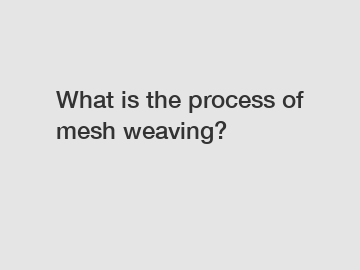What is the process of mesh weaving?
What is the process of mesh weaving?
Mesh weaving is a technique used to create intricate patterns by interlacing multiple strands of wire or thread. The process involves a series of steps that require skill, precision, and attention to detail. In this article, we will explore the process of mesh weaving, its origins, how it is proven to be an important technique, and the impact it has had on various industries.
The process of mesh weaving begins with selecting the appropriate material for the project. Depending on the desired outcome, different types of wire or thread can be used, such as stainless steel, copper, or nylon. These materials offer different strengths, textures, and appearances, allowing for endless possibilities in design.

Next, the selected material is prepared for weaving by being stretched and straightened. This step ensures that the wire or thread is free from any kinks or imperfections, which could interfere with the weaving process. Once the material is ready, it is carefully placed onto a loom or a frame that holds the threads in place.
The weaving process itself involves interlacing the horizontal threads, known as the weft, with the vertical threads, known as the warp. Different weaving techniques, such as plain weave, twill weave, or satin weave, can be used to create different patterns and textures. As the weft threads pass over and under the warp threads in a specific sequence, the mesh structure begins to take shape.
Attention to detail is crucial during the weaving process to ensure consistency, even tension, and precision. Weavers meticulously follow the predetermined pattern, counting every interlacement, and making adjustments as needed. This labor-intensive process requires patience and a steady hand, as even the slightest mistake can affect the overall appearance of the mesh.
The origins of mesh weaving can be traced back thousands of years. Historical artifacts, such as ancient Greek and Egyptian jewelry, depict the intricate beauty that can be achieved through this technique. Over time, mesh weaving has evolved and spread across cultures, each adding its unique touch to the craft.
Mesh weaving has proven to be an important technique in various industries. In modern times, it is widely used in the manufacturing of wire mesh products, jewelry making, textile production, and even in the field of architecture. The versatility of mesh weaving allows for its application in a wide range of fields, catering to both functional and artistic needs.
The impact of mesh weaving can be seen in the durability and strength of wire mesh products used in construction, filtration, and reinforcement. In the realm of fashion and jewelry, mesh weaving offers a unique and intricate design element that adds elegance and sophistication to accessories. The artistry of mesh weaving has also been recognized and celebrated, with numerous exhibitions and awards dedicated to this specialized craft.
In conclusion, mesh weaving is a process that involves interlacing multiple strands of wire or thread to create intricate patterns. Its origins date back centuries, and it has proven to be an important technique in various industries. With its versatility and artistic appeal, mesh weaving continues to have a significant impact on both functional and aesthetic aspects of our lives. Whether it is in jewelry, architecture, or manufacturing, the art of mesh weaving showcases the skill and creativity of artisans around the world.
Contact us to discuss your requirements of steel window mesh, pre-crimped wire mesh, lock crimp wire mesh. Our experienced sales team can help you identify the options that best suit your needs.

Comments